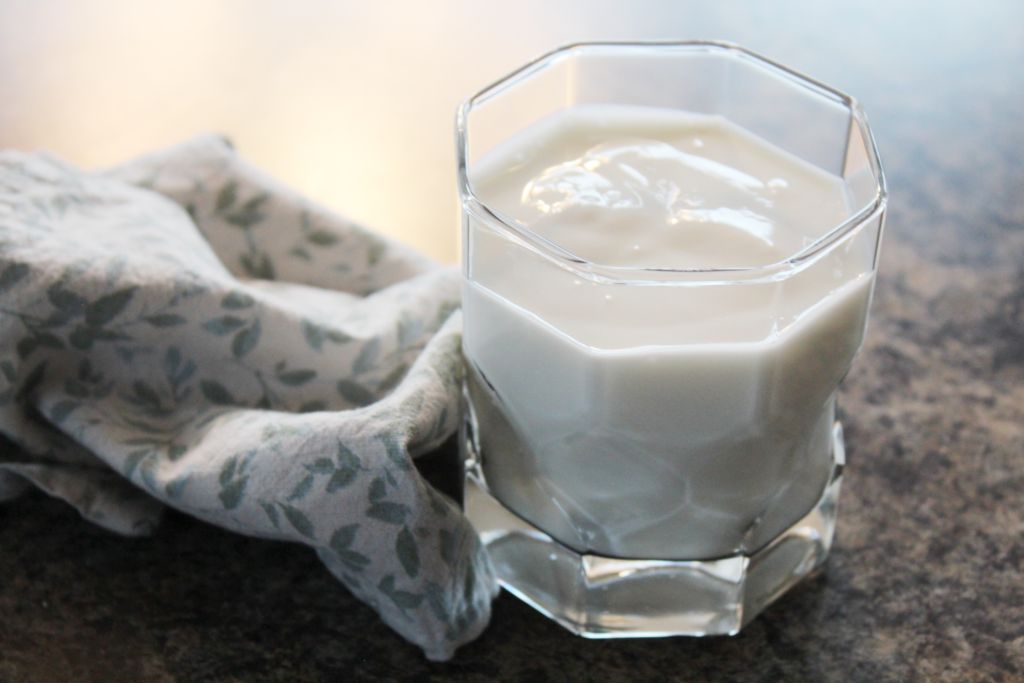Learn about the deliciously tangy drink, kefir, and how it can benefit your health.

Kefir was one of the very first fermented products we added to our life, and it will be a forever staple in our household. Not only is it delicious, but it also has numerous health benefits that make it a fantastic addition to any diet. So far, we only have experience with milk kefir, so that’s what we will primarily be referring to in this post.
What even is kefir?

Kefir is a tangy drink created by combining kefir grains with milk and allowing them to ferment overnight. Despite their name, kefir grains aren’t actually grains. They are a combination of various strains of yeast and bacteria living together in clusters. These “grains” have been used for hundreds of years to turn milk into a yogurt-like health drink. And thanks to the fermentation process that gives kefir its signature flavor, the lactose levels in milk kefir are significantly lower than in a cup of plain milk. This makes milk kefir a great alternative for many lactose-intolerant people.
There are two main types of kefir: water and milk. As we said previously, our only experiences have been with milk kefir grains, so we’ll mainly be discussing those. We would love to hear your thoughts on water kefir if you have experience working with water kefir grains. With milk kefir, you can use practically any milk. Goat milk was what kefir was originally made with, but cow’s milk has become the most popular. However, there are non-dairy alternatives, like coconut milk, you can experiment with if you are worried about using dairy.
What does milk kefir taste like?
In my opinion, milk kefir has a very similar taste to Greek yogurt. Kefir has a bit more tang and can even be slightly carbonated depending on the temperature and how long it fermented. However, compared to Greek yogurt, kefir is thinner and more akin to the texture of drinkable yogurt.
Store-bought kefir will have a much milder taste than homemade kefir. Along with this, the store-bought kind generally has additives to improve shelf life and flavoring. Our avoidance of unnecessary additives aside, store-bought kefir can be a great way to try kefir before taking the plunge and getting your own grains!
What are the health benefits of milk kefir?
Kefir has been used for centuries because of its effectiveness as a health drink. For starters, the living bacteria colonies in the kefir grains make for a phenomenal source of probiotics. Some sources say that milk kefir can have more probiotics per serving than yogurt. This massive collection of probiotics can work for your body in multiple ways, including improving your gut health, acting as an antibacterial, supporting bone health, and more.
How can you make milk kefir at home?

Making milk kefir is surprisingly simple, and the grains are incredibly resilient. All you need are some milk kefir grains, a mason jar, milk, and a nonmetal strainer. We also suggest using a nonmetal lid for the jar where you will be fermenting the kefir grains. We use a two-in-one lid that both covers the kefir and acts as a strainer.
- Add a tablespoon of kefir grains to a glass jar.
- Cover the grains with a cup of milk. (organic whole milk is preferred by our grains, but feel free to experiment with other kinds of milk)
- Cover the jar with either a piece of cloth or a kefir lid.
- Let it sit on the counter for 12–24 hours.
- Strain the liquid from your grains into a new glass jar.
- Place the strained kefir into the fridge for at least 12 hours to cool and thicken.
- Recover your kefir grains with another cup of milk.
- Repeat.
Technically speaking, kefir grains are a combination of living microorganisms. What that means for you is that as you feed your kefir grains, they will continue to grow. Anytime you have over a tablespoon of kefir grains in your milk, just separate the grains out so you have around a tablespoon again. The grains themselves are as edible as the kefir drink. You can eat the excess grains plain, blend them into a smoothie, or even feed them to your pets!
How can you use kefir?
Milk kefir can get very tangy, and may be too difficult to drink plain for some. But don’t fret, because the alternatives are endless! Here are some other ways you can use your kefir:
- Sourcream replacement
- Greek yogurt replacement
- Buttermilk replacement
- Liquid base for smoothies
- The base for creamy salad dressings
- Kefir ice cream or popsicles
- Milk replacement for cereal or oatmeal
- Facemasks
The kefir grains are as edible as the drink is, so you can eat the excess grains plain. Kefir grains have a texture similar to that of cottage cheese. If that’s not a texture you enjoy, you can also blend the grains into a smoothie. If you’re like us and your grains grow too fast for you to eat all the excess, you can also feed the grains to various pets like dogs and chickens. All of our pets, from the chickens to the parrots to the dogs, go crazy for the kefir whenever we cut the excess grains.
We hope our article has helped you become interested in trying either or both milk or water kefir, and we would love to hear your experiences with it. Since we use kefir as a cooking ingredient in many of our recipes, we would love to hear what recipes you have used your kefir in!


Leave a Reply
You must be logged in to post a comment.